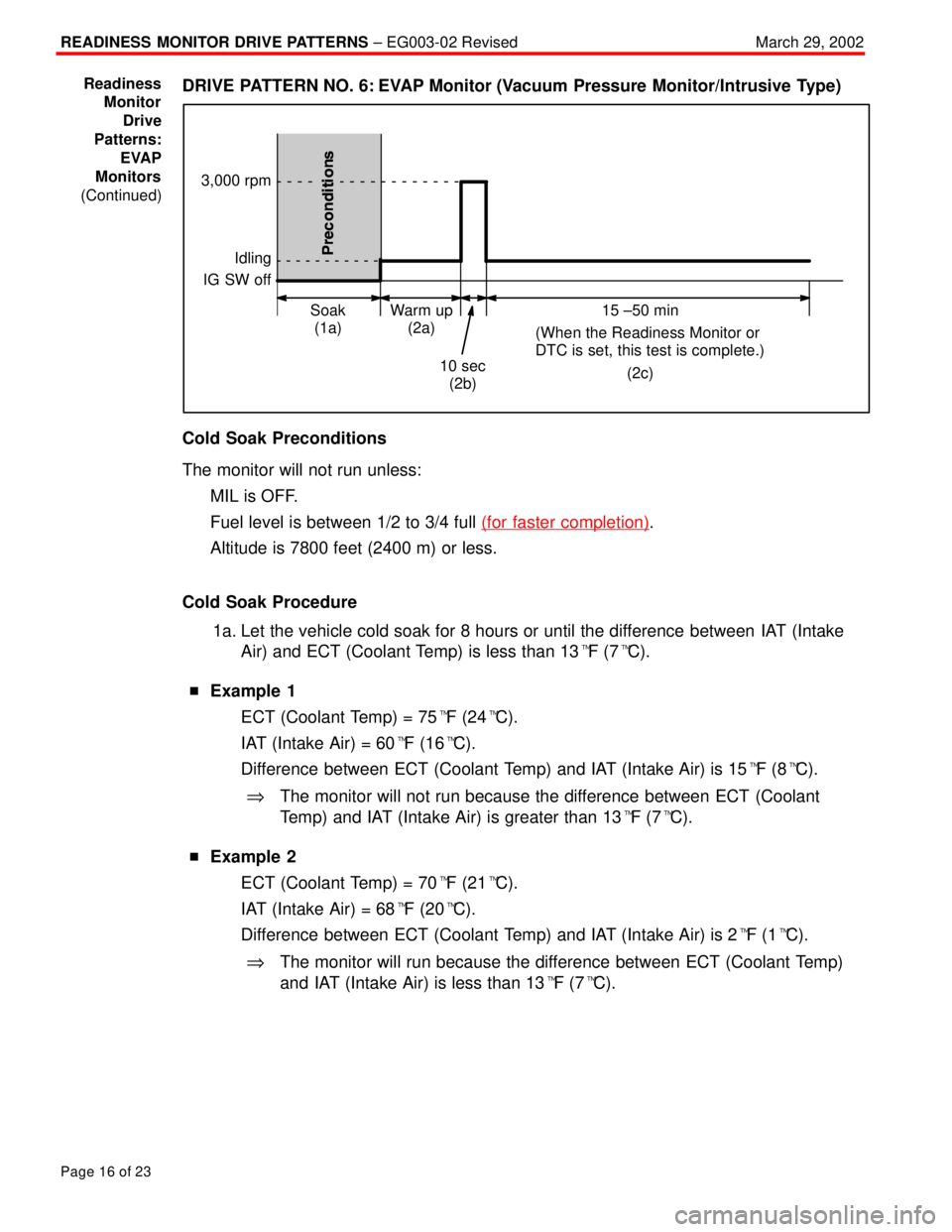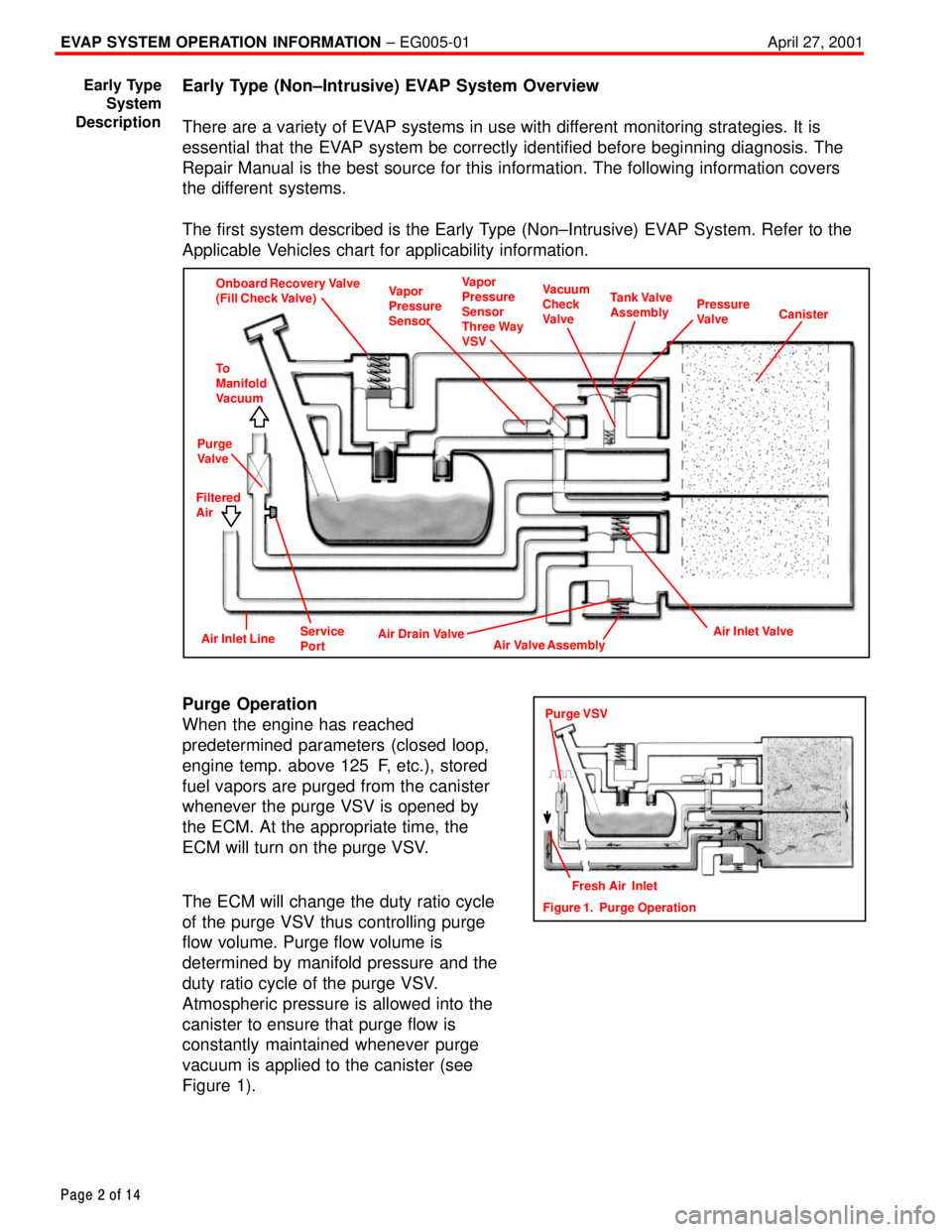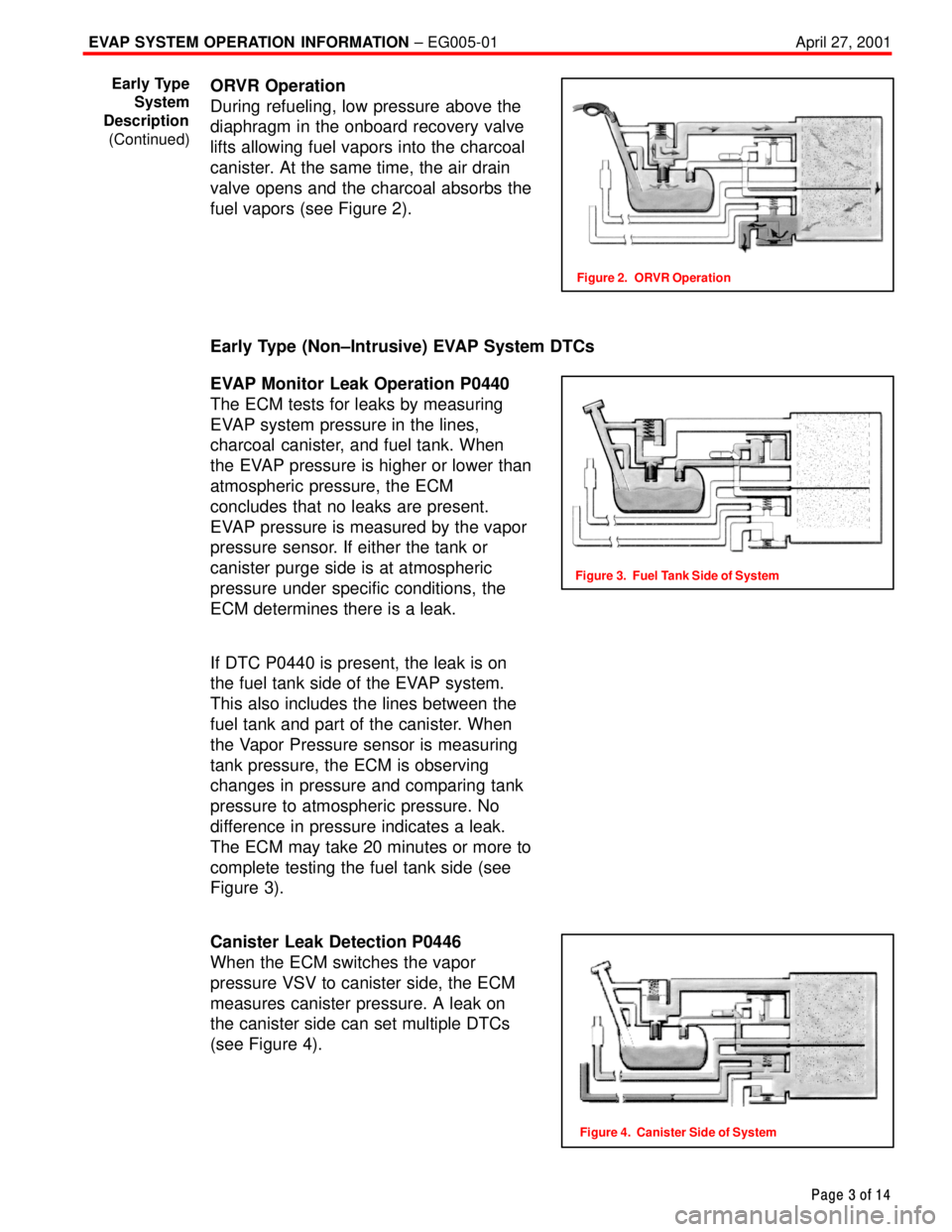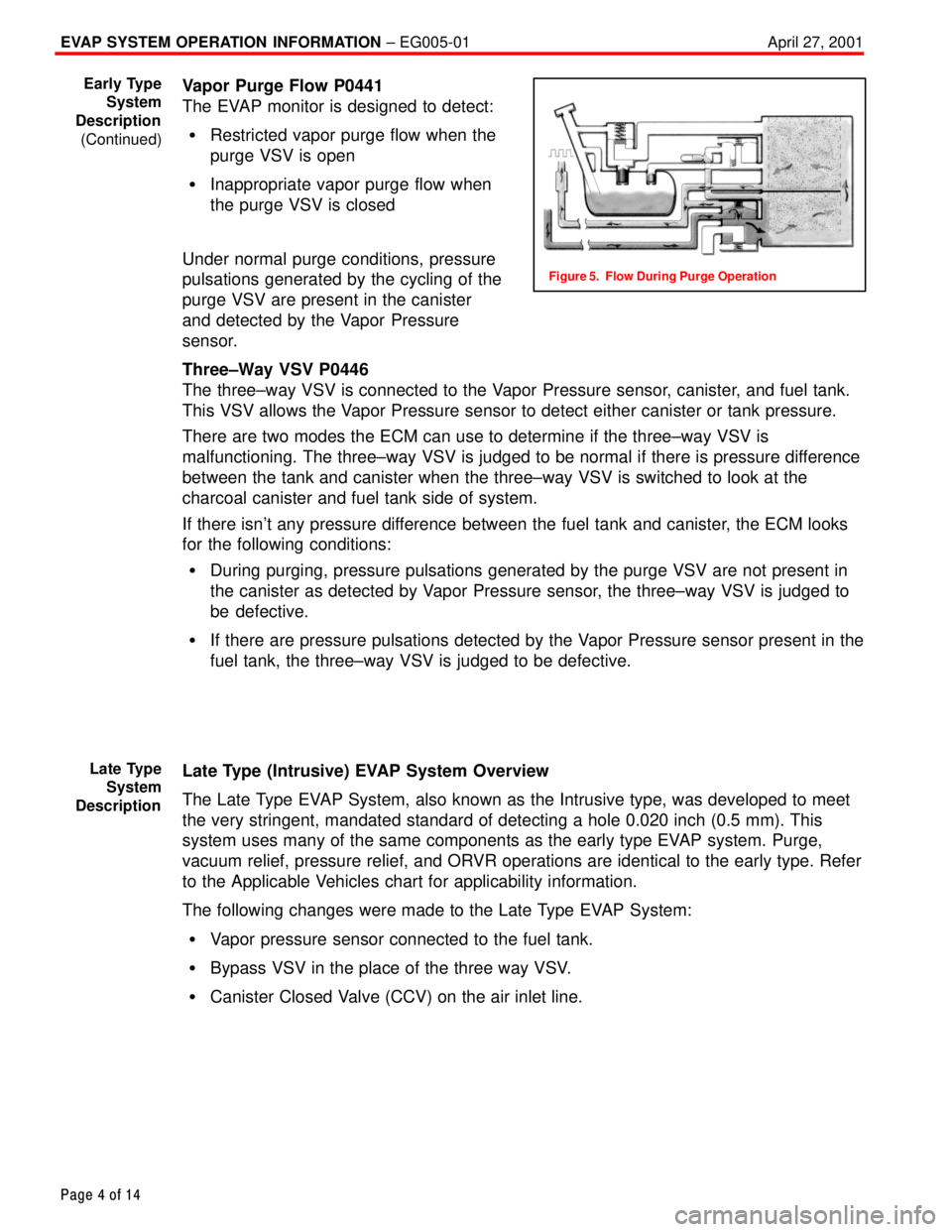Page 4545 of 4770

READINESS MONITOR DRIVE PATTERNS ± EG003-02 RevisedMarch 29, 2002
Page 14 of 23
DRIVE PATTERN NO. 5: EVAP Monitor
(Internal Pressure Monitor/Non±Intrusive Type)
45 mph
(72 km/h)
25 mph
(40 km/h)
Idling
IG SW off
Soak
(1b)5 min
(2a)15 min
(2b) Warm up
ECT.176�F
(1a)
Cold Soak Drive Pattern
Cold Soak Preconditions
The monitor will not run unless:
�MIL is OFF.
�Fuel level is between 1/2 to 3/4 full (for faster completion)
.
�Altitude is 7800 feet (2400 m) or less.
IMPORTANT:
A cold soak must be performed prior to conducting the drive pattern to complete the
Internal Pressure Readiness Monitor.
Cold Soak Procedure
1a. Start the engine and allow ECT (Coolant Temp) to reach 176�F (80�C) or greater.
(This can be done by letting the engine idle or by driving the vehicle.)
1b. Let the vehicle cold soak for 8 hours or until the difference between IAT (Intake
Air) and ECT (Coolant Temp) is less than 13�F (7�C).
�Example 1
�ECT (Coolant Temp) = 75�F (24�C).
�IAT (Intake Air) = 60�F (16�C).
�Difference between ECT (Coolant Temp) and IAT (Intake Air) is 15�F (8�C).
%The monitor will not run because the difference between ECT (Coolant
Temp) and IAT (Intake Air) is greater than 13�F (7�C).
�Example 2
�ECT (Coolant Temp) = 70�F (21�C).
�IAT (Intake Air) = 68�F (20�C).
�Difference between ECT (Coolant Temp) and IAT (Intake Air) is 2�F (1�C).
%The monitor will run because the difference between ECT (Coolant Temp)
and IAT (Intake Air) is less than 13�F (7�C).
Readiness
Monitor
Drive
Patterns:
EVAP
Monitors
Page 4547 of 4770

READINESS MONITOR DRIVE PATTERNS ± EG003-02 RevisedMarch 29, 2002
Page 16 of 23
DRIVE PATTERN NO. 6: EVAP Monitor (Vacuum Pressure Monitor/Intrusive Type)
Idling
IG SW off
Warm up
(2a) Soak
(1a)15 ±50 min
(When the Readiness Monitor or
DTC is set, this test is complete.)
(2c)
10 sec
(2b)
3,000 rpm
Cold Soak Preconditions
The monitor will not run unless:
�MIL is OFF.
�Fuel level is between 1/2 to 3/4 full (for faster completion)
.
�Altitude is 7800 feet (2400 m) or less.
Cold Soak Procedure
1a. Let the vehicle cold soak for 8 hours or until the difference between IAT (Intake
Air) and ECT (Coolant Temp) is less than 13�F (7�C).
�Example 1
�ECT (Coolant Temp) = 75�F (24�C).
�IAT (Intake Air) = 60�F (16�C).
�Difference between ECT (Coolant Temp) and IAT (Intake Air) is 15�F (8�C).
%The monitor will not run because the difference between ECT (Coolant
Temp) and IAT (Intake Air) is greater than 13�F (7�C).
�Example 2
�ECT (Coolant Temp) = 70�F (21�C).
�IAT (Intake Air) = 68�F (20�C).
�Difference between ECT (Coolant Temp) and IAT (Intake Air) is 2�F (1�C).
%The monitor will run because the difference between ECT (Coolant Temp)
and IAT (Intake Air) is less than 13�F (7�C).
Readiness
Monitor
Drive
Patterns:
EVAP
Monitors
(Continued)
Page 4561 of 4770

EVAP SYSTEM OPERATION INFORMATION ± EG005-01 April 27, 2001
Page 2 of 14
Early Type (Non±Intrusive) EVAP System Overview
There are a variety of EVAP systems in use with different monitoring strategies. It is
essential that the EVAP system be correctly identified before beginning diagnosis. The
Repair Manual is the best source for this information. The following information covers
the different systems.
The first system described is the Early Type (Non±Intrusive) EVAP System. Refer to the
Applicable Vehicles chart for applicability information.
Onboard Recovery Valve
(Fill Check Valve)Vapor
Pressure
SensorVapor
Pressure
Sensor
Three Way
VSVVacuum
Check
ValveTank Valve
AssemblyPressure
ValveCanister
To
Manifold
Vacuum
Purge
Valve
Filtered
Air
Air Drain Valve
Air Valve AssemblyAir Inlet ValveAir Inlet LineService
Port
Purge Operation
When the engine has reached
predetermined parameters (closed loop,
engine temp. above 125�F, etc.), stored
fuel vapors are purged from the canister
whenever the purge VSV is opened by
the ECM. At the appropriate time, the
ECM will turn on the purge VSV.
The ECM will change the duty ratio cycle
of the purge VSV thus controlling purge
flow volume. Purge flow volume is
determined by manifold pressure and the
duty ratio cycle of the purge VSV.
Atmospheric pressure is allowed into the
canister to ensure that purge flow is
constantly maintained whenever purge
vacuum is applied to the canister (see
Figure 1).
Early Type
System
Description
Figure 1. Purge OperationFresh Air Inlet
Purge VSV
Page 4562 of 4770

EVAP SYSTEM OPERATION INFORMATION ± EG005-01 April 27, 2001
Page 3 of 14
ORVR Operation
During refueling, low pressure above the
diaphragm in the onboard recovery valve
lifts allowing fuel vapors into the charcoal
canister. At the same time, the air drain
valve opens and the charcoal absorbs the
fuel vapors (see Figure 2).
Early Type (Non±Intrusive) EVAP System DTCs
EVAP Monitor Leak Operation P0440
The ECM tests for leaks by measuring
EVAP system pressure in the lines,
charcoal canister, and fuel tank. When
the EVAP pressure is higher or lower than
atmospheric pressure, the ECM
concludes that no leaks are present.
EVAP pressure is measured by the vapor
pressure sensor. If either the tank or
canister purge side is at atmospheric
pressure under specific conditions, the
ECM determines there is a leak.
If DTC P0440 is present, the leak is on
the fuel tank side of the EVAP system.
This also includes the lines between the
fuel tank and part of the canister. When
the Vapor Pressure sensor is measuring
tank pressure, the ECM is observing
changes in pressure and comparing tank
pressure to atmospheric pressure. No
difference in pressure indicates a leak.
The ECM may take 20 minutes or more to
complete testing the fuel tank side (see
Figure 3).
Canister Leak Detection P0446
When the ECM switches the vapor
pressure VSV to canister side, the ECM
measures canister pressure. A leak on
the canister side can set multiple DTCs
(see Figure 4).Early Type
System
Description
(Continued)
Figure 2. ORVR Operation
Figure 3. Fuel Tank Side of System
Figure 4. Canister Side of System
Page 4563 of 4770

EVAP SYSTEM OPERATION INFORMATION ± EG005-01 April 27, 2001
Page 4 of 14
Vapor Purge Flow P0441
The EVAP monitor is designed to detect:
�Restricted vapor purge flow when the
purge VSV is open
�Inappropriate vapor purge flow when
the purge VSV is closed
Under normal purge conditions, pressure
pulsations generated by the cycling of the
purge VSV are present in the canister
and detected by the Vapor Pressure
sensor.
Three±Way VSV P0446
The three±way VSV is connected to the Vapor Pressure sensor, canister, and fuel tank.
This VSV allows the Vapor Pressure sensor to detect either canister or tank pressure.
There are two modes the ECM can use to determine if the three±way VSV is
malfunctioning. The three±way VSV is judged to be normal if there is pressure difference
between the tank and canister when the three±way VSV is switched to look at the
charcoal canister and fuel tank side of system.
If there isn't any pressure difference between the fuel tank and canister, the ECM looks
for the following conditions:
�During purging, pressure pulsations generated by the purge VSV are not present in
the canister as detected by Vapor Pressure sensor, the three±way VSV is judged to
be defective.
�If there are pressure pulsations detected by the Vapor Pressure sensor present in the
fuel tank, the three±way VSV is judged to be defective.
Late Type (Intrusive) EVAP System Overview
The Late Type EVAP System, also known as the Intrusive type, was developed to meet
the very stringent, mandated standard of detecting a hole 0.020 inch (0.5 mm). This
system uses many of the same components as the early type EVAP system. Purge,
vacuum relief, pressure relief, and ORVR operations are identical to the early type. Refer
to the Applicable Vehicles chart for applicability information.
The following changes were made to the Late Type EVAP System:
�Vapor pressure sensor connected to the fuel tank.
�Bypass VSV in the place of the three way VSV.
�Canister Closed Valve (CCV) on the air inlet line.Early Type
System
Description
(Continued)
Figure 5. Flow During Purge Operation
Late Type
System
Description
Page 4564 of 4770
EVAP SYSTEM OPERATION INFORMATION ± EG005-01 April 27, 2001
Page 5 of 14
Late Type (Intrusive EVAP System) (Except ECHO)
Onboard Recovery Valve
(Fill Check Valve)Vapor
Pressure
SensorVacuum
Check
ValveTank Valve
AssemblyTank
Pressure
Valve
Canister
To
Manifold
Vacuum
Purge
VSV
Filtered
Air
Air Drain Valve
Air Valve AssemblyAir Inlet ValveCanister
Closed Valve
Bypass
VSVAir
Inlet LineService
Port
Tank Side
The bypass VSV and the fill check valve
assembly isolates the tank pressure side
from the canister side (see Figure 1).
Canister Side
The bypass VSV and the Fill Check valve
also isolate the canister side from the
tank side (see Figure 2).
Late Type
System
Description
(Continued)
Except ECHO
Figure 1. Fuel Tank Side of System
Except ECHO
Figure 2. Canister Side of System
Page 4566 of 4770
EVAP SYSTEM OPERATION INFORMATION ± EG005-01 April 27, 2001
Page 7 of 14
ECHO Monitor Sequence
CCV Open
Purge
ClosedOpenClosed
Purge ClosedOpen Open
Cold Start ECT/IAT
Near Same TempNegative
Pressure
(Vacuum)
OccursTank &
Canister
Leak CheckCCV
Testing Vapor
Pressure
Sensor
Signal
Monitor Operation
The monitor sequence begins with a cold
engine start. The IAT and ECT sensors
must have approximately the same
temperature reading.
The ECM is constantly monitoring fuel
tank pressure. As the temperature of the
fuel increases, pressure slowly rises.
The ECM will purge the charcoal canister
at the appropriate time (see Figure 1).
With bypass VSV closed, pressure will
continue to rise in fuel tank.
Late Type
System
Monitor
Sequence
(Continued)
Except ECHO
Figure 1. Canister Purge
ECHO
Figure 1. Canister Purge
Page 4568 of 4770
EVAP SYSTEM OPERATION INFORMATION ± EG005-01 April 27, 2001
Page 9 of 14
Vent Control, CCV Operation P0446
This stage checks the CCV and vent (air
inlet side) operation. When the vapor
pressure rises to a specified point, the
ECM opens the CCV. Pressure will
increase rapidly because of the air
allowed into the system. No increase or
an increase below specified rate of
pressure increase indicates a restriction
on the air inlet side (see Figure 4).
Bypass VSV Operation P0446
In the next stage, the ECM closes the
bypass VSV. This action blocks air
entering the tank side of the system. The
pressure rise on the fuel tank side is no
longer as great. If there was no change in
pressure, the ECM will conclude the
bypass VSV did not close (see Figure 5).Late Type
System
Monitor
Sequence
(Continued)Except ECHO
Figure 4. CCV Opens
ECHO
Figure 4. CCV Opens
Except ECHO
Figure 5. Bypass VSV Closes